Ah, spring is here in the D.C. area. The cherry blossoms are about to bloom, the forcythias are in bloom, the buds on our trees are about to pop, the robins returned, blue birds are flirting with each other, fish of all species are on the feed, and my lipless crankbaits are screaming out to me. Not too many fishing patterns get my blood pumping more than when big fish munch on lipless crankbaits.
 |
| Not only can you catch good numbers of fish on lipless crankbaits, but big ones too. This one fell for a Bill Lewis Rat-L-Trap in the Chrome Blue Back color. |
In our tidal rivers, blueback herring run into the skinny waters while largemouth bass, chain pickerel, and striped bass wait in ambush. Upriver, our smallmouth bass are on the feed. And, in local lakes and ponds, golden shiners swarm in the shallows, with predatory bass and pickerel ready to attack them for a tasty meal.
 |
| My friend Brad with a nice tidal largemouth bass that fell for a lipless crankbait. |
One of the best types of lure to offer these predatory fish are lipless crankbaits. I don't know if it's the vibration, rattling sound, or flash that drive these fish nuts enough to attack, or if it appeals to their extreme urge to feed prior to a rigorous spawn. I've heard arguments about both. But, seriously, when they're attacking these crankbaits, it doesn't matter why, just that they're hitting.
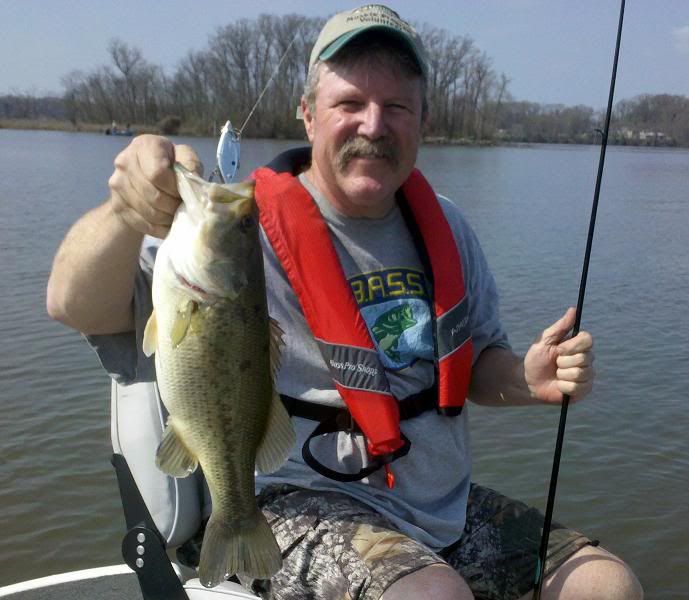 |
| Largemouth bass love lipless crankbaits, or hate them, depending on your view of why they attack them so violently. |
It's true, that I've seen fish come from a long way to hit these lures. Stripers are notorious for chasing down baitfish at high speeds. Largemouth bass are known to have extremely quick ambush attack speeds, but can also chase down a quickly retrieved lipless crank. Why? Like I said, who cares? Just that they do it, but honestly, it could be a combination of reasons.
Lipless crankbaits provide plenty of vibration that can be detected by an extremely sensitive organ in fish called the lateral line. When predatory fish sense these vibrations, the vibrations could provoke them into striking whatever is making them. Also, this extra sensitive organ allows fish to hone in on these lures from long distances away. The rattles in these lures could appeal to a feeding response, or just tick them off. At any rate, most of these lures have a loud rattling sound, teamed with their tight vibration, designed to trigger strikes. And, they most certainly do that well.
 |
| Gotta love what I call "trappin'" bass. Mark fooled this nice bass on a lipless crankbait. |
Whether you're fishing various colors or metallic finishes, most of these lures provide a measure of flash that could trigger strikes. I love the metallic finishes when skies are bright or if I'm fishing clearer water. Bright colors, like chartreuse, are great for fishing dingy water or dark days. In fact, dark colors also work well in those conditions. The action of the crankbait is key though, as the tight vibrating wiggle provides a flash that mimics their prey. This feature could also trigger reaction strikes or appeal to their feeding urges.
For anglers, these baits are attractive because you can fish them so many ways. You can just toss them out and crank them in. You can cast them out and jig them back, or fish directly below the boat in deep water and vertical jig. You can cast them out, let them sink, count them down, and fish them at any depth you desire. Or you can fish them slowly across the tops of weed beds and rip them off the weeds (more on that later). How much more versatile of a lure is there than that?
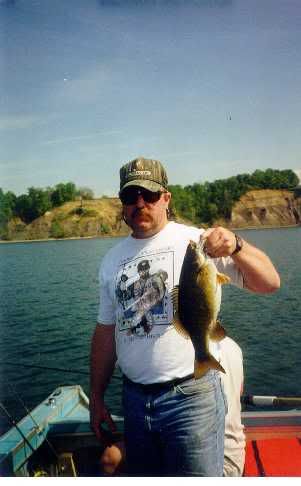 |
| There are many ways to fish these crankbaits. This pre-spawn Great Lakes smallmouth bass slammed a deep, slowly cranked lipless crankbait. |
One huge advantage to fishing this type of lure is that they cover a lot of water quickly. They're great search lures, especially when fishing new lakes. They're perfectly designed for finding for schooling predatory fish, or perhaps fish ambushing baitfish on a windy point. When the fish are on, you can catch good numbers of them on these lures for this reason, and not only that, potentially big fish. They're
big fish baits!
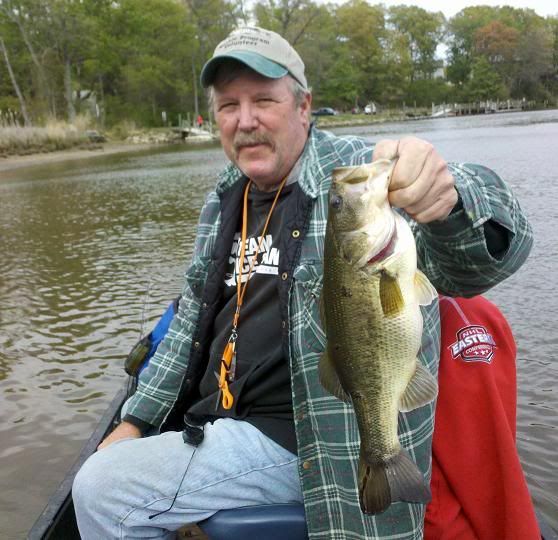 |
| You cover water with lipless crankbaits to find chunky largemouth bass like this. |
So, for those out there who don't know what a lipless crankbait is, they're basically a type of plug that is about a half inch or less in width, laterally compressed (almost flat), that sink on the fall, and don't have a lip like other crankbaits do. Most of them have some sort of rattling system inside them. The line tie is at the top of the "head" of the lure. All of these features make them unique.
There are many brands out there, most of them produce well. We all have our favorites. I fish several different brands, because each one has a slightly different presentation, but they all have similar traits mentioned above. I like the Bill Lewis Rat-L-Trap, Rapala Rattlin' Rap, Strike King Red Eyed Shad, and Yo-Zuri Rattl'n Vibe. Each has their place in my box. I carry four different sizes, depending on what I'm fishing for, being 1 oz., 3/4 oz., 1/2 oz. and 1/4 oz. There are other brands that probably work just as well, but it's up to you to find your favorites.
If I had to say that I have a favorite or "go to" version, the first one that I tie on, one that catches just about any predatory fish, it's a 1/2 ounce Bill Lewis Rat-L-Trap. I love the Chrome Blue Back color when fishing our tidal waters, as I feel it resembles the blue back herring. Maybe it does, or maybe it doesn't, but that thought gives me confidence that this will work, and it usually does.
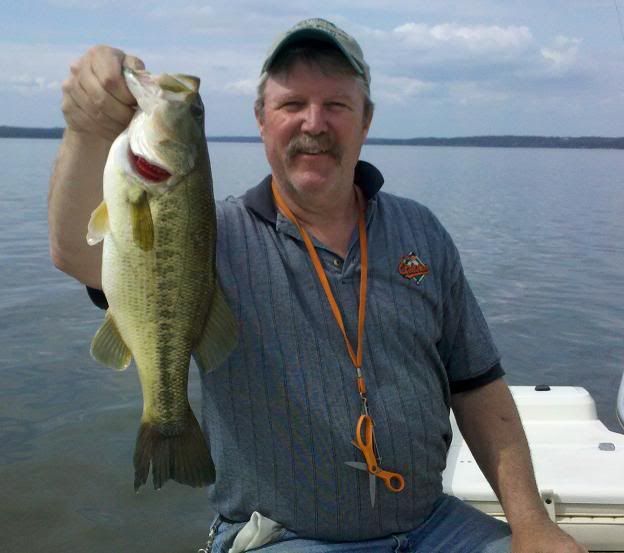 |
| Shad and blueback herring run up river to spawn in the spring. Lipless crankbaits are great imitators of these baitfish. I like the Chrome Blue Back Rat-L-Trap for this purpose. Nice largemouth, like this one, stripers and other predatory fish feast on them, and will do the same on your lipless crankbait. |
For lakes and ponds, I love the Gold Black Back color this time of year. I think that they resemble golden shiners, and in tannic acid stained waters, maybe resemble shad as well. That said, there are other colors that could be effective in other situations or water conditions. The colors mentioned above work best for me if there is about two feet or more visibility. Truthfully, I think that color is the least important feature, except perhaps the metallic finishes, because they provide a lot of flash, as do baitfish.
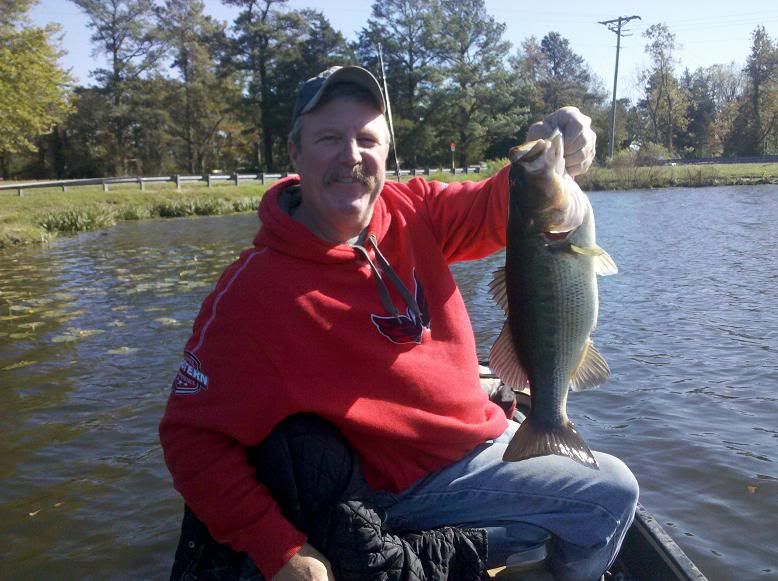 |
| This chunky largemouth fell for a Gold Black Back 1/2 ounce Rat-L-Trap. There are plenty of golden shiners in our lakes, so if your lakes have a good population of them, try the gold "trap". |
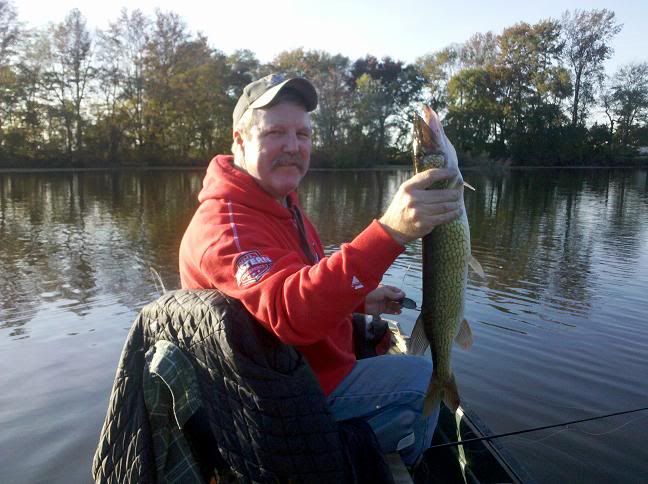 |
| Chain pickerel love the golden shiner imitation as well. |
So, how do you fish them? Like I said above, there are many ways to fish lipless cranks. But, in spring time, which is the focus of this article, I'll mention my favorite pattern for largemouth. During spring, some weeds are beginning to grow, while others have already been growing and are now filling in, and these weeds attract baitfish. Equally important, is that weeds provide ambush cover and break up the silhouette of predatory fish on the bottom. Most predatory fish, like bass, are dark on the top, and light underneath. So, when they sit on the bottom in wait, they blend in with the weeds very well. When cover like this attracts both predators and prey, it's a fishing hot spot.
In this situation, I try to fish just over the top of the weeds and let the treble hooks tick the tops of the weeds. When the lure gets to the edge of the weed bed, I let it drop and flutter down, then rip it up and crank it back. Often, when bass fishing, ripping a lure like this off the bottom will trigger strikes. Also, lures that flutter down over weed bed edges could provoke a predatory fish hiding below. As the crank flutters down, the fish think it is an easy meal, and attack it on the fall.
 |
| Steve will tell you that fishing over the top of weed beds with lipless crankbaits will catch big bass, and here's the proof! |
When fishing over top of the weeds, your lure will hang up on weeds occasionally. Don't just reel your lure in and clean it off. When that happens, as long as it isn't a thick mat, rip the lure from the weeds with the rod tip and continue fishing the lure. As with ripping a lure off the bottom, ripping one off weeds may also provoke vicious strikes from largemouth. Again, the flash, vibration, and darting action of the lure when ripped off the weed is key, I believe, to provoking bass into striking. This is the pattern, really.
How do I keep a sinking lure above the weeds? I keep my rod tip up when reeling, and if the weeds are a foot under the surface, keep it higher. This also allows you to reel in the lure a little slower, and I feel, making the lure more attractive to bass. If you do this while keeping your rod tip down, you will have to fish the lure much faster to keep the lure up enough, or you will bury your lure in the weeds, leading to frustration and less productive casts.
I prefer using a long, fast action baitcasting bass rig for this, with braided line. I used to use fluorocarbon line, and that worked well too. The low stretch lines and long, fast action rods enable you to keep the lure above the weeds, and to rip the lure off of the weeds and clear it, while also provoking fish to strike. My pitching rod and reel work great for this technique.
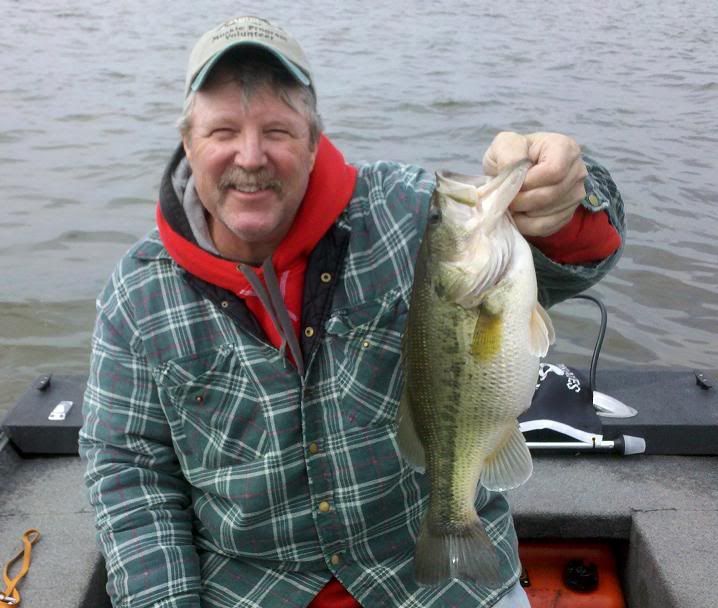 |
| This largemouth, and countless others like this, were caught on the weed pattern described above. |
Striped bass, or stripers or rockfish, as they call them in my neck of the woods, love lipless cranks too. You can fish them any number of ways, but if I had to say one thing about them for stripers is that they like them fast, and they like erratic. So, crank it in, let it stop, rip it, then crank as fast as you can, then rinse, repeat. Stripers can out swim your lure no matter how fast you reel, if they want it. That said, if they're deep, you have to let it sink down there so they can see it first. That's the beauty of these lures, really, their versatility, and that they simply catch fish.
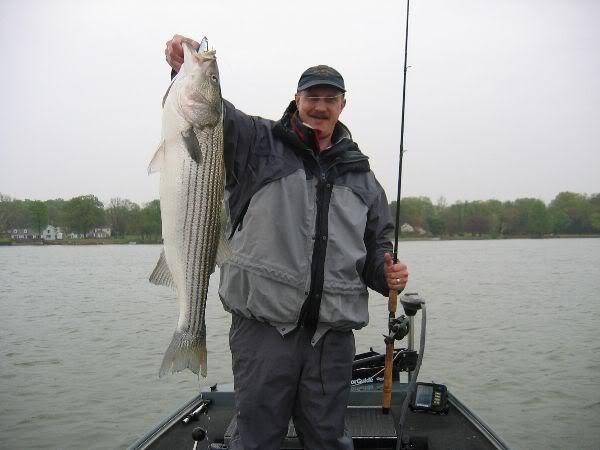 |
| My buddy Bob with a nice striper that he caught on a 1 ounce Rat-L-Trap. |
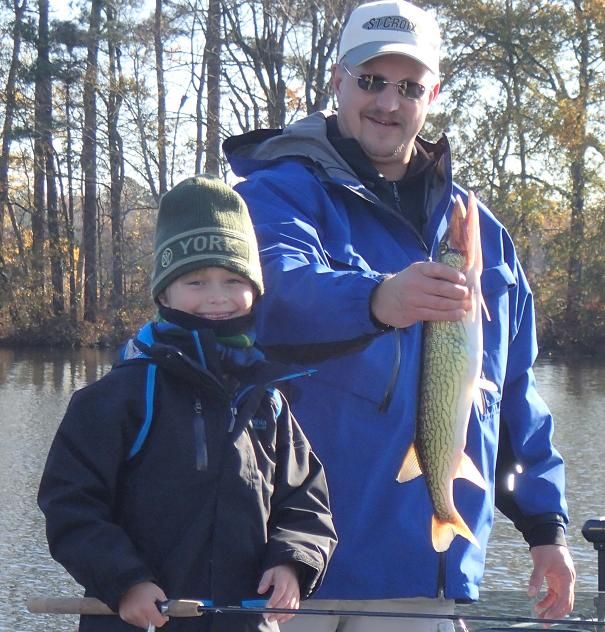 |
| Carson (left) and his Dad, Bob, with a nice chainside caught on a lipless crankbait. This time, the fish fell for a 1/4 oz. Rat-L-Trap in the Chrome Blue Back color. |
The lure shape resembles a shad remarkably well. When you think about it, they could resemble just about any form of baitfish as long as the predators don't have much time to examine the lure. Perhaps that is why these lures are so effective?
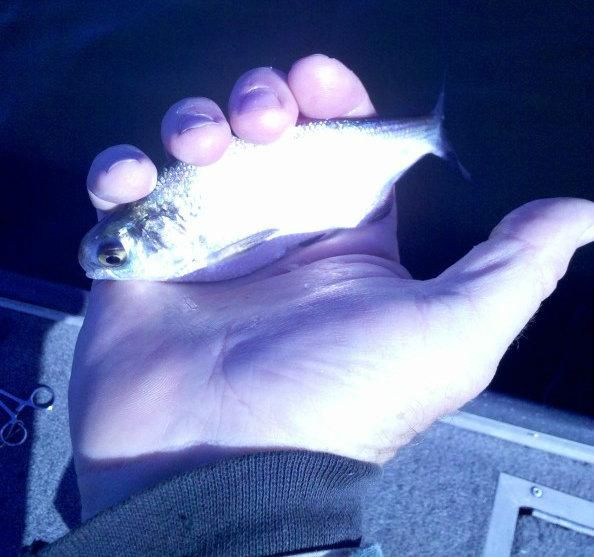 |
| Shad, like this one, are abundant in our rivers, and in some of our lakes and ponds. Lipless crankbaits are great lures that mimic these baitfish. Lipless crankbaits match them in size, shape, flash, and even action. |
I fish the larger sizes for larger predators, like stripers, pike, and even musky. I prefer the half once size for bass, but there are times when the 1/4 ounce size is necessary. The 1/4 ounce size will also catch perch, crappie, trout and other panfish.
The coolest thing about lipless crankbaits is that they can catch just about any predatory fish out there. I caught my biggest king salmon on a black Cotton Cordell Hot Spot, and another huge one on a chartreuse Rat-L-Trap. I've caught northern pike, walleye, lake trout, steelhead, large brown trout, and even catfish on them. These lures work well on many saltwater species as well, especially bluefish and sea trout. Talk about a versatile lure, eh?
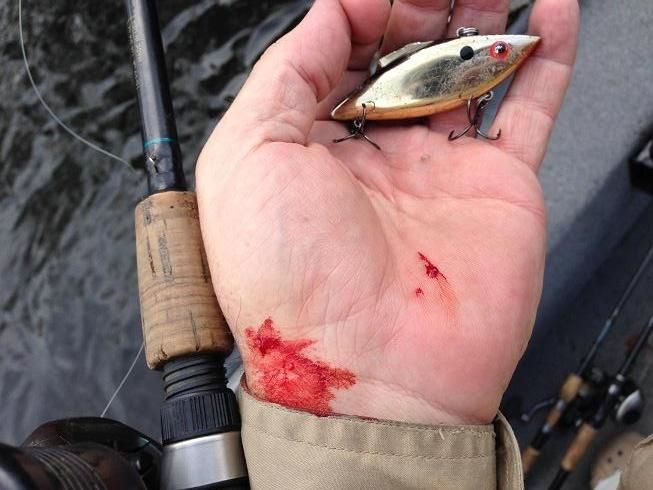 |
| Oh yeah, a warning, as with any treble hooked lure, when unhooking fish, be careful. I reached to unhook a chain pickerel, and the slimy fish slid down and the hooks both lodged into my hand, still attached to the fish while it thrashed about. Talk about painful! Luckily, this time, I was able to grab the fish while my buddy got the hooks out of it. The hook that went into the middle of my palm popped right out, but the hook mark on the left took some handy plier work. Fortunately, it came out quickly. After all, I'm not a surgeon, but I did stay at a Holiday Inn a few times! |
So, when the early signs of spring reach your area, if you haven't already, give lipless crankbaits a try. By the way, they work well all year. However, they're my "go to" lure during spring and early fall. So get out there and give them a try! If this helps you catch a big fish, please leave me a comment and tell me the story!















No comments:
Post a Comment